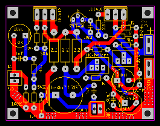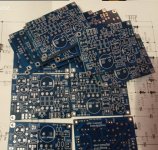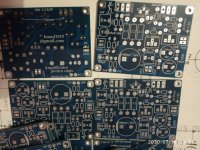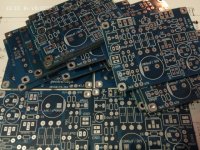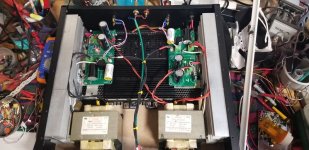What do you mean by 'modern competition'? The design is rather 'old' but same goes for several other amplifiers. Please specify the amplifiers you have in mind 
So far this one is the only one in my hands. Salas' DCG3 is on its way though.
Maybe others can give you more information of this headphone amplifier compare to recent ones.
So far this one is the only one in my hands. Salas' DCG3 is on its way though.
Maybe others can give you more information of this headphone amplifier compare to recent ones.
How does this amp compare with modern competion?
Incomparable to many branded amplifiers sold at quite high prices.
It is true that they look better but the appearance is too unimportant. The headphones you listen to also matter.
I do not recommend headphones with extra bass, noise cancellation and other crap for unpretentious consumers. I recommend open or semi-open headphones.
Personally, I prefer AKGs that have a more adequate price than what they offer compared to other established companies.
AKG K 712PRO can be a good recommendation (strictly personal opinion).
The amplifier itself is quite versatile. You can change values of some components, supply voltage, bias ... etc.
In general, the project deserves to be approached, being easy to understand.
This week I will order some PCBs from the factory and it is possible to make some pieces available.
Attachments
Hello!
My iteration of the tortello design:
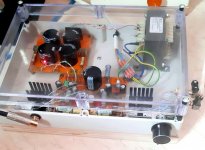
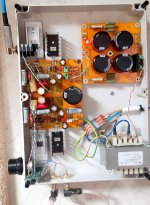
It runs on +24VDC as suggested, with a slightly beefed-up PSU.
Input capacitors are in parallel with ex-Soviet PIO and Silver Mica.
Output electrolytic capacitors are in parallel with ex-Soviet PIO, Silver Mica and Wima FKP.
All others are bypassed with either polypropylene or polyester caps (some are hiding beneath the PCB).
Plus one ex-soviet PIO you can see standing next to the PSU electrolytic.
In terms of sound, it really does a great job!
If I'd try to describe it, it combines solid-state clarity and accuracy with a bit of tube 'spirit'.
It is dead quiet and I hear no thump on turn-on.
Biased at around 200mV.
It is a powerful amplifier that will drive pretty much anything.
I am using it with my HD599 cans at the moment and my 50kOhm potentiometer is set to 1/4 of a turn.
Mosfets can get pretty hot, so they obviously need proper heat-sinks.
Thanks again to tortello (and Nelson Pass) for sharing this simple and great sounding design.
My iteration of the tortello design:


It runs on +24VDC as suggested, with a slightly beefed-up PSU.
Input capacitors are in parallel with ex-Soviet PIO and Silver Mica.
Output electrolytic capacitors are in parallel with ex-Soviet PIO, Silver Mica and Wima FKP.
All others are bypassed with either polypropylene or polyester caps (some are hiding beneath the PCB).
Plus one ex-soviet PIO you can see standing next to the PSU electrolytic.
In terms of sound, it really does a great job!
If I'd try to describe it, it combines solid-state clarity and accuracy with a bit of tube 'spirit'.
It is dead quiet and I hear no thump on turn-on.
Biased at around 200mV.
It is a powerful amplifier that will drive pretty much anything.
I am using it with my HD599 cans at the moment and my 50kOhm potentiometer is set to 1/4 of a turn.
Mosfets can get pretty hot, so they obviously need proper heat-sinks.
Thanks again to tortello (and Nelson Pass) for sharing this simple and great sounding design.
Nice work!Here is the schematic of my headphone amplifier, a simple circuit based on the Zen idea, with the exploitation of the Pass Labs patent # 5,710,522.
This increases a lot some circuit features, such as distortion and driving capability:thanks again for your open-mind, Nelson!
With the schematic values I obtain over 8Vpp onto a 22Ohm load (!), with about 1% of T.H.D., but what really matters is that with my Grado 325 I obtain a very good sound, far better than with the RA-1.
The gain is 3.2, or about 10dB, the input impedance about 40KOhm, without the volume pot.
Fine settings:
R4 should be set to obtain the requested drain bias current: I chose 300mA;
R15 should be set to obtain about 1/2 B + on TP1;
R8 should be set to obtain i (R10) = i (R12) in dynamic conditions, for example
with a 1KHz sinewave at the input.
The pass [Pass?!] -band is about 4Hz-25KHz: if you want to extend this, you should change R9 into 68K, R14 into 10K and R15 into 56K, the input impedance decreases to about 10KHz: the values must be adjusted as above.
Feel free to change values, bias current and P.S. voltage.
I like its sound very much, I'll be very glad if you will build it and tell me what do you think, thanks to all for this!
P.S. The image is not so good, I know...: if anyone wants a better .pdf file, please let me know.
Tortello
On SE Class A amps, the stereo imaging might be not so good if the channel separation is compromised from a common PSU rail that doesn’t have any local bulk capacitance to isolate fluctuations. You can test this by listening to left channel while only inputing signal to right channel etc. this can be fixed with an extra CRC between the PSU and each channel. About 2200uF and 2.2ohms should work.
Also, for 32ohm headphones use 2200uF output caps for deeper bass extension. Bypass with a 2.2uF film cap for good HF extension. Your chassis and system looks really good nice and clean. If you are into simple Class A headphone amps that have slam and only 0dB gain, check out the LuFo Lite.
Attachments
You are right about the separate rails.Nice work!
On SE Class A amps, the stereo imaging might be not so good if the channel separation is compromised from a common PSU rail that doesn’t have any local bulk capacitance to isolate fluctuations. You can test this by listening to left channel while only inputing signal to right channel etc. this can be fixed with an extra CRC between the PSU and each channel. About 2200uF and 2.2ohms should work.
Also, for 32ohm headphones use 2200uF output caps for deeper bass extension. Bypass with a 2.2uF film cap for good HF extension. Your chassis and system looks really good nice and clean. If you are into simple Class A headphone amps that have slam and only 0dB gain, check out the LuFo Lite.
I might do a version 2.0 with separate PSU rails and PCBs for each channel.
I use 1000uF of capacitance for the output due to limited space. I might squeeze a larger cap there as you said.
Regarding your unity gain design, it definitely suits my taste. I will look into it.
Thanks!
- Home
- Amplifiers
- Pass Labs
- ZEN-like headphones amp
